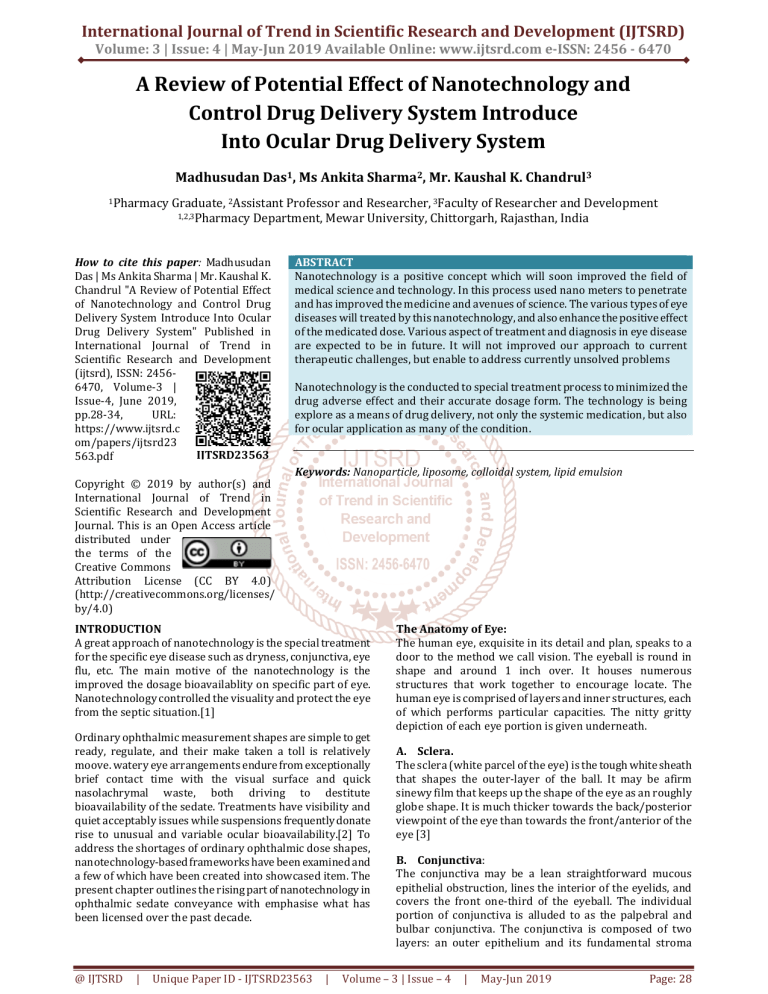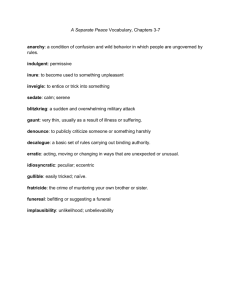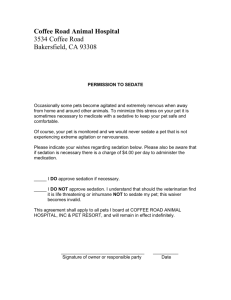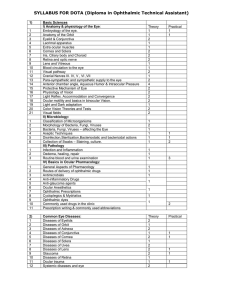
International Journal of Trend in Scientific Research and Development (IJTSRD)
Volume: 3 | Issue: 4 | May-Jun 2019 Available Online: www.ijtsrd.com e-ISSN: 2456 - 6470
A Review of Potential Effect of Nanotechnology and
Control Drug Delivery System Introduce
Into Ocular Drug Delivery System
Madhusudan Das1, Ms Ankita Sharma2, Mr. Kaushal K. Chandrul3
1Pharmacy
Graduate, 2Assistant Professor and Researcher, 3Faculty of Researcher and Development
1,2,3Pharmacy Department, Mewar University, Chittorgarh, Rajasthan, India
How to cite this paper: Madhusudan
Das | Ms Ankita Sharma | Mr. Kaushal K.
Chandrul "A Review of Potential Effect
of Nanotechnology and Control Drug
Delivery System Introduce Into Ocular
Drug Delivery System" Published in
International Journal of Trend in
Scientific Research and Development
(ijtsrd), ISSN: 24566470, Volume-3 |
Issue-4, June 2019,
pp.28-34,
URL:
https://www.ijtsrd.c
om/papers/ijtsrd23
IJTSRD23563
563.pdf
Copyright © 2019 by author(s) and
International Journal of Trend in
Scientific Research and Development
Journal. This is an Open Access article
distributed under
the terms of the
Creative Commons
Attribution License (CC BY 4.0)
(http://creativecommons.org/licenses/
by/4.0)
ABSTRACT
Nanotechnology is a positive concept which will soon improved the field of
medical science and technology. In this process used nano meters to penetrate
and has improved the medicine and avenues of science. The various types of eye
diseases will treated by this nanotechnology, and also enhance the positive effect
of the medicated dose. Various aspect of treatment and diagnosis in eye disease
are expected to be in future. It will not improved our approach to current
therapeutic challenges, but enable to address currently unsolved problems
Nanotechnology is the conducted to special treatment process to minimized the
drug adverse effect and their accurate dosage form. The technology is being
explore as a means of drug delivery, not only the systemic medication, but also
for ocular application as many of the condition.
Keywords: Nanoparticle, liposome, colloidal system, lipid emulsion
INTRODUCTION
A great approach of nanotechnology is the special treatment
for the specific eye disease such as dryness, conjunctiva, eye
flu, etc. The main motive of the nanotechnology is the
improved the dosage bioavailablity on specific part of eye.
Nanotechnology controlled the visuality and protect the eye
from the septic situation.[1]
Ordinary ophthalmic measurement shapes are simple to get
ready, regulate, and their make taken a toll is relatively
moove. watery eye arrangements endure from exceptionally
brief contact time with the visual surface and quick
nasolachrymal waste, both driving to destitute
bioavailability of the sedate. Treatments have visibility and
quiet acceptably issues while suspensions frequently donate
rise to unusual and variable ocular bioavailability.[2] To
address the shortages of ordinary ophthalmic dose shapes,
nanotechnology-based frameworks have been examined and
a few of which have been created into showcased item. The
present chapter outlines the rising part of nanotechnology in
ophthalmic sedate conveyance with emphasise what has
been licensed over the past decade.
@ IJTSRD
|
Unique Paper ID - IJTSRD23563
|
The Anatomy of Eye:
The human eye, exquisite in its detail and plan, speaks to a
door to the method we call vision. The eyeball is round in
shape and around 1 inch over. It houses numerous
structures that work together to encourage locate. The
human eye is comprised of layers and inner structures, each
of which performs particular capacities. The nitty gritty
depiction of each eye portion is given underneath.
A. Sclera.
The sclera (white parcel of the eye) is the tough white sheath
that shapes the outer-layer of the ball. It may be afirm
sinewy film that keeps up the shape of the eye as an roughly
globe shape. It is much thicker towards the back/posterior
viewpoint of the eye than towards the front/anterior of the
eye [3]
B. Conjunctiva:
The conjunctiva may be a lean straightforward mucous
epithelial obstruction, lines the interior of the eyelids, and
covers the front one-third of the eyeball. The individual
portion of conjunctiva is alluded to as the palpebral and
bulbar conjunctiva. The conjunctiva is composed of two
layers: an outer epithelium and its fundamental stroma
Volume – 3 | Issue – 4
|
May-Jun 2019
Page: 28
International Journal of Trend in Scientific Research and Development (IJTSRD) @ www.ijtsrd.com eISSN: 2456-6470
(substantia propria). The uncovered surface of the eye
includes conjunctiva and cornea and is secured with the tear
film. The conjunctiva contributes to the arrangement of the
tear film by way of emitting significant electrolytes
C. Cornea.
The cornea may be a solid clear bulge found at the front of
the eye. Surface of the grown-up cornea encompasses a
sweep of approximately 8mm. It has an imperative optical
work as it refracts light entering the eye which at that point
passes through the student and onto the focal point (which
at that point centers the light onto the retina). The cornea, a
non-vascular structure (does not contain any blood vessels)
gets the essential nutrients from the capillaries that end in
circles at its circumference. It is provided by numerous
nerves determined from the ciliary nerves.[3] These enter
the covered tissue of the cornea. It is in this manner greatly
sensitive.
D. Aquas humour.
The fluid humor may be a jelly-like substance located within
the outer/front chamber of the eye. It could be a watery fluid
that fills the "front chamber of the eye" which is located
promptly behind the cornea and before the lens. The watery
humor is exceptionally marginally antacid salt solution that
incorporates minor amounts of sodium and chloride ions. It
is ceaselessly delivered, basically by the ciliary processes,
streams from the back chamber through the pupil into the
front chamber, and exits through the trabecular route at the
point and the uveoscleral course. Schlemm's canal (canal of
Schlemm or the scleral venous sinus), is a circular channel
that collects watery amusingness from the anterior chamber
and conveys it into the circulation system by means of the
anterior ciliary veins.[4]
E. Pupil.
Understudy by and large shows up to be the dull "middle" of
the eye, but can be more precisely depicted as the circular
aperture within the middle of the iris through which light
passes into the eye. The size of the student (and thus the
amount of light that's conceded into the eye) is directed by
the pupillary reflex (too known as the "light reflex").
F. Iris.
The iris could be a lean circular contractile shade located in
front of the focal point but behind the cornea. The iris is a
diaphragm of variable estimate whose work is to alter the
size of the student to control the sum of light admitted into
the eye. It is the coloured portion of the eye (shades may
vary separately like blue, green, brown, hazel, or dim)
G. Choroid.
The choroid layer is found behind the retina and absorbs
unused radiation and feeds the external parcels of the retina.
It could be a lean, highly vascular (i.e. it contains blood
vessels) layer that's dull brown in colour and contains a
shade that assimilates abundance light and so anticipates
blurred vision (due to as well much light on the retina). The
choroid has one of the most elevated blood streams within
the body.
H. Vitreous humor.
The vitreous funniness (moreover known as the vitreous
body) is found within the huge region that occupies
approximately 80% of each eye within the human body. The
vitreous funniness could be a flawlessly straightforward
thin-jelly-like substance that fills the chamber behind the
@ IJTSRD
|
Unique Paper ID - IJTSRD23563
|
focal point of the eye.[4] It is an albuminous liquid encased
in a fragile transparent membrane called the hyaloid layer.
Different mode of ocular drug delivery:
Topical route
Ordinarily topical visual medicate organization is
accomplished by eye drops, but they have as it were a short
contact time on the eye surface.[5] The contact, and thereby
duration of medicate activity, can be delayed by formulation
design (e.g.m gels, gelifying details, treatments, and inserts)
Subconjunctival administration
Customarily subconjunctival infusions have been used to
provide drugs at expanded levels to the uvea. Currently this
mode of medicate conveyance has picked up new
momentum for different reasons. The advance in materials
sciences and pharmaceutical definition have given new
exciting conceivable outcomes to create controlled release
formulations to convey drugs to the back portion and to
guide the mending handle after surgery.[5]
Intravitreal administration
Coordinate sedate organization into the vitreous offers
distinct advantage of more direct get to to the vitreous and
retina. It ought to be famous; in any case that delivery from
the vitreous to the choroid is more complicated due to the
prevention by the RPE (Retinal Pigment Epithelium)
obstruction. Little particles are able to diffuse quickly within
the vitreous but the versatility of large molecules, especially
emphatically charged, is limited.
Barrier for ocular drug delivery
Drug loss from the ocular surface
After ingrained, the stream of lacrimal fluid removes
ingraining compounds from the surface of eye. Even though
the lacrimal turnover rate is as it were around 1 µl/min the
excess volume of the ingraining liquid is flown to the
nasolacrimal conduit quickly in some of minutes.[5] Another
source of non-productive sedate evacuation is its systemic
absorption rather than visual retention. Systemic absorption
may take put either straightforwardly from the conjunctival
sac via local blood capillaries or after the arrangement
stream to the nasal cavity.
Lacrimal fluid eye barrier
Corneal epithelium limits sedate assimilation from the
lacrimal liquid into the eye. The corneal epithelial cells form
tight intersections that restrain the paracellular medicate
permeation. Therefore, lipophilic drugs have ordinarily at
slightest an order of greatness higher porousness within the
cornea than the hydrophilic drugs.
Blood ocular barrier
The eye is ensured from the xenobiotics in the blood stream
by blood-ocular obstructions. These boundaries have two
parts: blood-aqueous boundary and blood-retina barrier.
The front blood-eye obstruction is composed of the
endothelial cells within the uveam (The center layer of the
eye beneath the the sclera.[5] It comprises of the iris, ciliary
body, and choroid). This boundary avoids the get to of
plasma albumin into the watery humor, conjointly limits the
get to of hydrophilic drugs from plasma into the fluid humor.
The posterior obstruction between blood stream and eye is
comprised of retinal shade epithelium (RPE) and the tight
dividers of retinal capillaries. Not at all like retinal capillaries
the vasculature of the choroid has broad blood stream and
cracked walls. Drugs effortlessly pick up get to to the
Volume – 3 | Issue – 4
|
May-Jun 2019
Page: 29
International Journal of Trend in Scientific Research and Development (IJTSRD) @ www.ijtsrd.com eISSN: 2456-6470
choroidal extravascular space, but there after distribution
into the retina is constrained by the RPE and retinal
endothelia
Mechanism of ocular drug absorption
Drugs managed by ingrained must penetrate the eye and do
so essentially through the cornea taken after by the noncorneal courses. These non-corneal courses involve drug
dissemination over the conjunctiva and sclera and appear to
be especially imperative for drugs that are poorly absorbed
over the cornea [5].
Various barrier to drug absorption
In tears have a coordinate bearing on proficiency of drug
absorption into the inward eye. The profitable retention of
most ophthalmic drugs comes about from diffusional process
across corneal membrane. The proficiency of absorption
process could be a work of rate and degree at which the
transport forms of eye. The flux of any sedate molecule
across the natural layer depends on the physicochemical
properties of the penetrating particle and its interaction with
the film. The degree to which the transport or assimilation
prepare happens is additionally work of physiological
instrument of precorneal liquid seepage or turnover. In
terms of transcorneal medicate penetration, the cornea can
be considered to comprise of three essential layers
(epithelium, stroma and endothelium). The epithelium and
endothelium contain on the order of a 100 overlap more
noteworthy sum of lipid fabric than the stroma. [5]Thus,
depending on the physicochemical properties of a diffusing
medicate, the resistance advertised by the individual layers
changes incredibly. Epithelium, being lipodal, represents a
diffusional obstruction advertising tall resistance toionic or
other watery dissolvable or polar species. In contrast,
compounds with generally moo extremity experience a
greater diffusional resistance within the hydrophilic stroma
layer. This frequently cited concept of sedate penetration
over the corneal film ism alluded to as “differential solubility
concept
Various factor responsible for dispotion of occuler drug.
Bioavailability of drugs managed to the eye is an critical
thought. There are physiological factors, which can influence
a drug’s bioavailability counting protein binding, medicate
digestion system and lachrymal seepage. Protein bound
drugs are unfit of penetrating the corneal epithelium due to
the estimate of the protein drug complex. Since of the brief
time in which an ophthalmic solution may stay show within
the eye (due to lachrymal drainage), protein official of a
sedate substance may quickly negate its restorative esteem
by rendering it inaccessible for absorption. One of the major
issues experienced with conventional ophthalmic
arrangements is the quick and extensive elimination of drugs
from the precorneal lachrymal liquid. It must be famous that
this tall seepage rate is due to the tendency of the eye to
preserve its home volume at 7– 10 µl for all time, though
volumes topically instilled range from 20–50 µL. In reality it
has been illustrated in vivo that 90% of the dosage was
cleared inside 2 min for an instilled volume of 50 µL and,
inside 4 min for an instilled volume of 10 µl. Subsequently,
the ocular residence time of conventional arrangements is
constrained to some minutes, and the overall absIn
expansion to the physiological variables affecting ocular
bioavailability, other variables as the physicochemical
properties of the sedate substance, and item formulation are
imperative. Since the cornea could be a membrane-barrier
@ IJTSRD
|
Unique Paper ID - IJTSRD23563
|
containing both hydrophilic and lipophilic layers, it is
permeated most viably by sedate substances having both
hydrophilic and lipophilic characteristics. It is advantageous
for corneal infiltration to alter the pH of the solution to
increase the extent of unionized medicate within the
ingraining dose.
Nasolachrymal drainage system
The nasolachrymal seepage framework comprises of three
parts: the secretory framework, the distributive framework
and the excretory framework. The secretory framework
comprises of basic secretors that are fortified by squinting
and temperature change due to tear vanishing The
distributive framework comprises of the eyelids and the tear
meniscus around the cover edges of the open eye, which
spread tears over the visual surface by squinting, thus
preventing dry ranges from creating. The excretory portion
of the nasolachrymal seepage framework comprises of: the
lachrymal puncta, the prevalent, second rate and common
canaliculi; the lachrymal sac and the nasolachrymal conduit.
In humans, the two puncta are the openings of the lachrymal
canaliculi and are arranged on an hoisted range known as
the lachrymal papilla. It is thought that tears are largely
absorbed by the mucous layer that lines the conduits and the
lachrymal sac as it were a little sum comes to the nasal
passage [6]and reflex secretors that have an efferent
parasympathetic nerve supply and discharge in response to
physical or enthusiastic incitement.
Need to introduced novel drug system in ocular drug
delivery:
Ophthalmic medicate conveyance is one of the most
interesting and challenging endeavors confronting the
pharmaceutical researcher. The scene of ophthalmic drug
delivery is profoundly competitive and quickly advancing.
New classes of pharmaceuticals and biologics are fueling the
demand for novel sedate delivery. The primary point of
pharmaco therapeutics is the attainment of compelling
sedate concentration at the location of action for the
adequate period of time to evoke a response. The challenge
is to supply a framework with progressed ocular drug
bioavailability and drawn out term of action, but still with a
least chance of visual complications. A major problem of
ophthalmic sedate conveyance isn't the need of efficient
drugs but the fulfillment of their optimal concentration at
the location of their ideal concentration at the site of activity
[5,6].
The development of unused and inventive implies for
improving restorative adequacy proposes that a greater
choice of dose shapes will be given to doctors and patients
within the following decade. Most of the detailing efforts aim
at maximizing visual medicate assimilation through
prolongation of the drug home time within the cornea and
conjunctival sac, as well as to moderate sedate discharge
from the delivery framework and minimize precorneal
sedate misfortune. Various ophthalmic definitions and their
home time period in the visual depression are given
underneath [7]
Formulation Deseign:
Ophthalmic drugs are defined to bring the active drugs in
contact with the eye surface to permit for absorption.
Expansion of corneal contact time may result in increased
sedate entrance & higher intraocular drug delivery. In
expansion to the dynamic medicate, ophthalmic
formulations ought to contain other fixings to control
Volume – 3 | Issue – 4
|
May-Jun 2019
Page: 30
International Journal of Trend in Scientific Research and Development (IJTSRD) @ www.ijtsrd.com eISSN: 2456-6470
various characteristics of the detailing, such as the buffering
and pH, osmolality & tonicity, thickness & antimicrobial
additives. In spite of the fact that these fixings are listed
dormant, they can influence porousness of sedate across the
visual surface boundaries & change the therapeutic
effectiveness of the sedate.
Controle of ocular infection:
Visual diseases, both shallow and profound such as
conjunctivitis, corneal ulcers and endophthalmitis are
caused by differing bunch of microbes, viral and fungal
pathogens. Appropriately the armamentarium of available
antimicrobials utilized within the anticipation and treatment
of these infections incorporates antivirals, antifungals and
antibacterials. Common topical antibacterials utilized in
treatment of ocular infectious illnesses incorporate
sulfonamides,
aminoglycosides,
polymyxin-based
combinations and fluoroquinolones. These fluoroquinolones
are demonstrated for extreme bacterial keratitis,
endophthalmitis, blepharo-conjunctivitis, corneal ulcers,
chronic post-filtration hypotony etc. The fluoroquinolones
represent an growing course of wide spectrum antibacterials
which cover a have of Gram negative and anaerobic species
capable for visual diseases. These antibacterials have picked
up notoriety within the ophthalmology field since they have
been appeared to be comparable to combination treatment
in treatment
Fluoroquinolones offer all the qualities of an ideal
antimicrobial operator counting wide antimicrobial
spectrum, good tissue entrance and bioavailability, tall rate
of clearance, chemical and organic steadiness, moo degree of
toxicity, tall authoritative partiality for melanin, superior
patient compliance, helpful dose shapes and dosing schedule
and moderately moo rate of sedate intuitive.
Mode of Action:
Fluoroquinolones act by repressing two enzymes involved in
bacterial DNA union, both of which are DNA topoisomerases
that human cells need which are essential for bacterial DNA
replication, subsequently enabling these operators to be
both particular and bactericidal. DNA topoisomerases are
dependable for isolating the strands of duplex bacterial DNA,
embeddings another strand of DNA through the break, and
after that resealing the originally separated strands.
DNA gyrase presents negative superhelical twists within the
bacterial DNA doublehelix ahead of the replication fork,
subsequently catalyzing the division of daughter
chromosomes. This action is fundamental for initiation of
DNA replication and permits for authoritative of initiation
proteins. Topoisomerase IV is mindful for decatenation
that's, evacuating the interlinking of daughter chromosomes
in this manner permitting isolation into two daughter cells at
the conclusion of a circular of replication. Fluoroquinolones
connected with the enzyme-bound DNA complex (i.e., DNA
gyrase with bacterial DNA or topoisomerase IV with
bacterial DNA) to create conformational changes that result
within the restraint of normal protein movement. As a result,
the modern drug– enzyme–DNA complex blocks movement
of the replication fork, subsequently inhibiting normal
bacterial DNA union and eventually coming about in rapid
bacterial cell passing. More seasoned fluoroquinolones show
a relatively steady design with regard to specificity of
enzyme restraint in several sorts of microscopic organisms.
The newer fourth era fluoroquinolones like moxifloxacin,
gatifloxacin have a dual-binding instrument of action,
@ IJTSRD
|
Unique Paper ID - IJTSRD23563
|
inhibiting both DNA gyrase and topoisomerase IV, in
Grampositive species [8,9].
Types of Nanotechnology for used in ocular drug
delivery:
Types of lipid emulsion:
LEs are biphasic framework of immiscible fluids (either w/o
or o/w types) and one related with soundness issues
happening due to aggregation and coalescence of the
globules stacking to phase separation [10]. LEs are
thermodynamically steady and colloidal. Ls cattering,
stabilized by interfacial film of emulsifier. In ocular drug
conveyance, they are related with a few points of interest
which include sterilization, tall clarity, and ease of
arrangement [11].
Oil in water (o/w) lipid emulsion:
These sorts of emulsion are arranged by utilizing of oil
droplet surrounded by surfactant film. The fluid stage is
employments as persistent stage, in which oil beads are
dispersed. In this type of emulsions, drugs are joined in oil
stage and optimized emulsion in best condition [12]. It offers
different points of interest which include a straightforward
visual sedate conveyance framework, higher stability,
sustained impact, and medicate conveyance to more
profound layers of the eye and aqueous humor. Diverse
drugs like azithromycin, difluprednate etc has been
conveyed by this sort of LEs.
Water in oil (w/o) lipid emulsion:
These sorts of emulsion are for the most part utilized for the
hydrophilic drugs. The most points of interest related with
w/o sort emulsion is spontaneous arrangement and
thermodynamically soundness [13]. It has been utilized for
the conveyance of certain drugs like dexamethasone,
tobramycin [14], chloramphenicol [15]
Bicontineous lipid emulsion:
In this sort of emulsion, oil and water both exist in continues
phase so called as bicontinuous emulsion. The rheological
property exhibits non-newtonian stream. The characteristic
property is water and oil particle are interlaced which see
like crisscross structure [16]. A characteristic property of
bicontinous emulsion is that the aqueous and oil nanodomain are isolated by surfactant monolayer [17]. A
bicontinous emulsion silicone oil was created and
characterized for the diverse parameters to appear its
applicability as the cleansing specialists.
Liposome:
Liposomes are phospholipid bilayer vesicles for focusing on
the drugs to the particular location within the body [18].
They give controlled and specific sedate conveyance through
upgraded BA [19] and their potential in visual sedate
conveyance appears more for lipophilic than. hydrophilic
compounds [20]. Liposomes have extra benefit of being
completely biodegradable and by and large nontoxic, but
stability is exceptionally destitute than particulate polymeric
medicate conveyance system. Liposomes are developing
devices for sedate conveyance for administration of number
of drugs to the eye [21] such as ibuprofen [22], flurbiprofen
[23].
Hathout et al. (2007) detailed acetazolamide liposome
appeared the emphatically charged and neutral liposomes
shown more prominent bringing down in IOP and a more
prolonged impact than the adversely charged ones. It was
Volume – 3 | Issue – 4
|
May-Jun 2019
Page: 31
International Journal of Trend in Scientific Research and Development (IJTSRD) @ www.ijtsrd.com eISSN: 2456-6470
suggested that liposomes have improved corneal
penetration of medicate by being adsorbed onto the corneal
surface, with direct exchange of sedate from liposomes to
epithelial cell membranes. Sedate stacking capacity and
entanglement efficiency of liposomes depends on numerous
components such as measure of liposomes, concentration
and sorts of lipid utilized, and physicochemical properties of
restorative operator itself. The loading capacity and capture
proficiency was moo for Small unilamellar vesicles (SUV) in
comparison to Multivesicular vesicles (MLV). In any case,
Expansive unilamellar vesicles (LUV) give a adjust between
measure, loading capacity and capture proficiency (Ding et
al., 2005; Jesorka & Orwar, 2008).
Colloidal system:
Visual sedate conveyance is one of the foremost curiously
and challenging endeavors confronting pharmaceutical
scientists because of the basic and pharmacokinetically
specific environment that exists within the eye. The life
structures, physiology and natural chemistry of the eye give
a special structure that restricts the section of sedate
particles at the specified location of action and impenetrable
to remote substances. A suitable ocular detailing ought to
discharge the medicate overcoming the protective
boundaries of the eye without causing permanent tissue
harm (Ghate & Edelhauser, 2006; Urtti, 2006). There are
numerous courses of visual organization like topical
instillation and subconjunctival infusion for front portion,
while periocular and intravitreal infusions, and topical
dosing for back fragment. [24]
A fastidious see toward the past of visual delivery clearly
emphasizes eye drops as the central and most frequently
utilized definition for visual conveyance. In spite of the fact
that eye drops are simple to fabricate and quiet compliant
but their application is seriously full with issues related to
their poor bioavailability (1–10%). The destitute
bioavailability of eye drop may be due to credited restricted
range of retention
Microemulsion:
A picky see toward the past of visual conveyance clearly
emphasizes eye drops as the central and most habitually
utilized definition for visual movement. In show disdain
toward of the truth that eye drops are basic to manufacture
and calm compliant but their application is genuinely full
with issues related to their destitute bioavailability (1–10%).
The dejected bioavailability of eye drop may be due to
credited limited extend of maintenance. MEs have pulled in a
extraordinary intrigued as DDS for topical ocular application
since of little measure, basic and cheap arrangement, can be
sterilized effortlessly by filtration (Soukharev et al., 2005),
moo thickness, more prominent capacity as drug carrier,
retention promoter, and moo surface pressure of MEs, show
spreading on the cornea blending with the precorneal film
constituents (Fialho & da Silva-Cunha, 2004). MEs as carriers
for drugs to transport lipophilic and hydrophilic substances
through their individual medium, i.e. an watery medium and
lipoid medium, and thus move forward the bioavailability
(Ma et al., 2008; Kesavan et al., 2013). The infiltration
upgrading property of surfactant and co-surfactant of MEs
increases the medicate penetrability (sedate take-up) and
encourages the passage of sedate by corneal film.
Nanoparticle:
NPs are one of the most-studied colloidal frameworks with
the object of moving forward focusing on of medicate to
@ IJTSRD
|
Unique Paper ID - IJTSRD23563
|
organs and increasing drug bioavailability over biologic
films. NPs are submicroscopic, colloidal framework
comprising of macromolecular substances that change in
measure from 10 to 1000 nm. In NPs, the drug may be
broken down, entangled, adsorbed, joined or encapsulated
into the polymer framework. Depending on the method of
arrangement, it can be classified into two bunches: NPs
(nanospheres) and nanocapsules and have distinctive
release profile of medicate (Sahoo et al., 2003; Vandervoor et
al., 2007). Nanospheres are little strong circles constituting
of dense solid polymeric organize having huge surface
region. Drugs can either be joined within the network
framework or adsorbed on the surface of the nanospheres.
On the other hand, nanocapsules have little central depth
(sleek bead) encompassed by a polymeric film. NPs speak to
promising drug carriers for ophthalmic applications. After
optimal binding to these particles, the sedate retention
within the eye is enhanced altogether in comparison to eye
drop solutions owing to the much slower visual disposal rate
of particles. Smaller particles are superior endured by the
patients than larger particles therefore NPs may be an
awfully comfortably to be utilized for drawn out activity
ophthalmic DDS. Different polymers can be utilized to
manufacture NPs such as biodegradable polymers like
polylactides, poly (D,L-lactides).
Mode of action of control drug delivery:
Diffusion
Within the Dissemination component, the sedate is released
continuously at a controlled rate through the membrane into
the tear liquid. In the event that the embed is formed of a
strong non-erodible body with pores and scattered medicate.
The discharge of sedate can take place by means of
dissemination through the pores. Controlled release can be
encourage controlled by gradual dissolution of strong
scattered sedate inside this matrix as a result of internal
dissemination of aqueous solutions. In a solvent gadget,
genuine disintegration.
In swelling-controlled gadgets, the dynamic operator is
homogeneously scattered in a smooth polymer. Since shiny
polymers are basically drug impermeable, no dissemination
through the dry matrix occurs. When the embed is put
within the eye, water from the tear liquid starts to enter the
matrix, at that point swelling and subsequently polymer
chain unwinding and sedate dissemination take place. The
disintegration of the network, which takes after the swelling
handle, depends on polymer structure: linear shapeless
polymers break up much faster than cross-linked or
somewhat crystalline polymers. Discharge from these
gadgets takes after in general Fickian 'square root of time'
energy; in some occurrences, in any case, known as case II
transport, zero arrange energy has been watched.
Osmosis:
Within the Osmosis instrument, the embed comprises a
transverse impermeable versatile membrane dividing the
insides of the embed into a first compartment and a moment
compartment; the first compartment is bounded by a semipermeable membrane and the impermeable elastic
membrane, and the moment compartment is bounded by an
impermeable material and the elastic film. There's a sedate
release aperture within the impermeable divider of the
insert. The to begin with compartment contains a solute
which cannot pass through the semi-permeable [24]. layer
and the moment compartment provides a store for the
Volume – 3 | Issue – 4
|
May-Jun 2019
Page: 32
International Journal of Trend in Scientific Research and Development (IJTSRD) @ www.ijtsrd.com eISSN: 2456-6470
sedate which once more is in fluid or gel form. When the
embed is put within the aqueous environment of the eye,
water diffuses into the first compartment and extends the
elastic membrane to extend the primary compartment and
contract the moment compartment so that the drug is
constrained through the sedate discharge gap.
Bioerosion:
Within the Bioerosion component, the configuration of the
body of the embed is constituted from a matrix of
bioerodible fabric in which the drug is scattered. Contact of
the embed with tear fluid results in controlled supported
discharge of the drug by bioerosion of the framework. The
medicate may be dispersed consistently all through the
lattice but itis accepted a more controlled discharge is
obtained if the sedate is externally concentrated in the
matrix. In really erodible or E-type gadgets, the rate of
sedate discharge is controlled by a chemical or enzymatic
hydrolytic response that leads to polymer solubilization, or
corruption to smaller, water-soluble atoms. These polymers,
as specified by Heller, [24] may experience bulk or surface
hydrolysis. Erodible embeds undergoing surface hydrolysis
can show zero arrange release kinetics; given that the
gadgets keep up a constant surface geometry which the
medicate is poorly water-soluble
Discussion:
Modern ophthalmic conveyance framework incorporates
ocular inserts, collagen shields, visual movies, expendable
contact lens and other Novel sedate conveyance frameworks
like hiosomes 20 and nanoparticles. More current drift could
be a combination of drug delivery innovations for moving
forward the therapeutic response of a non useful sedate.
This will donate a superior dosage shapes for topical
ophthalmic application. Among these medicate conveyance
frameworks, as it were few items have been,
commercialized. An perfect framework ought to have
successful medicate, concentration at the target tissue for a
tended period of time with least systemic impact.
Understanding acknowledgment is very important for the
plan of any comfortable ophthalmic drug conveyance
framework. Major Enhancements are required in each
framework like advancement in maintained sedate release,
large scale fabricating and steadiness. Combination of drug
conveyance frameworks might open a modern order for
improving the restorative reaction of a non-efficacious
system. They can overcome the restrictions and combine the
advantages of distinctive frameworks.
NPs are one of the most-studied colloidal frameworks with
the object of moving forward
Declaration:
The article was checked by the authorities of researcher and
development (Mewar University) and they not found any
inconvenience issue.
References:
[1] Zarbin MA, Montemagno, Leary JF, Ritch
Nanotechnology
in
ophthalmology,
Can
ophthalmol.2010 oct.45[5];457-76
R.
J
[2] Burke P. Nanotechnology.2005. spring. Graduate class
of tought at university. of California, Irvine.
@ IJTSRD
|
Unique Paper ID - IJTSRD23563
|
[3] Urtti A. Challenge and obstacle of ocular
pharmacokinetics and drug delivery. Adv drug delivery
rev, 58, 2006, 1131-35
[4] Jtirvinena K, Tomi J, Urttia SA. ocular absoption
following topical delivery. Adv. drug dev, 16, 1995, 319
[5]
Meqi SA, Deshpande SG. Ocular drug delivery; control
and novel drug delivery. New delhi ;CBS
publishers;2002;82-84
[6] Eva M, Amo D, Urtti A, current and future ophthalmic
drug delivery system. A shift to the posterior segment
drug discov to day;2004,135-45
[7] Blondeau JM, fluroquinolones, Mechanism of action,
classification and development of resistances. Surv
ophthalmol, 49 ;2004; 73-78
[8] Desai PN, synthesis and characterization of polyionic
hydrogela, Bechalor of homeopathic medicine ana
surgery, LMF, homeopathic medical college, india.
[9] He C, Kim SW, Lee DS. insetu gelling stimuli-senstive
block copolymer hydrogels for drug delivery. J control
release, 127,2008, 189-207.
[10] Pera-Titus M, Leclercq L, Clacens JM, De Campo F,
Nardello-Rataj V. Pickeringinterfacial catalysis for
biphasic systems: from emulsion design to
greenreactions. Angew Chem Int Ed 2015;54:2006–21.
[11] Madni A, Rahem MA, Tahir N, Sarfraz M, Jabar A,
Rehman M, et al. Noninvasivestrategies for targeting
the
posterior
segment
of
eye.
Int
J
Pharm2017;530:326–45.
[12] Daull P, Lallemand F, Garrigue JS. Benefits of
cetalkonium
chloride
cationic
oilin-water
nanoemulsions for topical ophthalmic drug delivery. J
PharmPharmacol 2014; 66:531–41.
[13] Lallemand F, Garrigue JS, Philips B, inventors; Santen
Sas, assignee. Water-inoil type emulsion for treating a
disease of the eye. United States patent US9, 107, 822.
2015.
[14] 14. Bachu RD, Stepanski M, Alzhrani RM, Jung R, Boddu
SH. Development andevaluation of a novel
microemulsion of dexamethasone and tobramycin
fortopical ocular administration. J Ocul Pharmacol
Ther;
2018.
doi:http://doi.org/10.1089/jop.2017.0082.
[Epub
ahead of print].
[15] Ashara KC, Shah KV. Emulsion of chloramphenicol: an
overwhelming approachfor ocular delivery. Folia Med
2017; 59:23–30.
[16] Gomes GV, Sola MR, Marostegan LF, Jange CG, Cazado
CP, Pinheiro AC, et al.Physico-chemical stability and in
vitro digestibility of beta-carotene-loadedlipid
nanoparticles of cupuacu butter (Theobroma
grandiflorum) produced bythe phase inversion
temperature (PIT) method. J Food Eng 2017;192:93–
102
Volume – 3 | Issue – 4
|
May-Jun 2019
Page: 33
International Journal of Trend in Scientific Research and Development (IJTSRD) @ www.ijtsrd.com eISSN: 2456-6470
[17] Sharma AK, Garg T, Goyal AK, Rath G. Role of
microemuslsions in advanced drug delivery. Artif Cells
Nanomed Biotechnol 2016; 44:1177–85.
[18] Jain P, Rahi P, Pandey V, Asati S, Soni V. Nanostructure
lipid carriers: a modishcontrivance to overcome the
ultraviolet effects. EJBAS 2017; 4:89–100.
[19] Bansal D, Yadav K, Pandey V, Ganeshpurkar A,
Agnihotri A, Dubey N. Lactobionic acid coupled
liposomes:
an
innovative
strategy
for
targetinghepatocellular carcinoma. Drug Deliv 2016;
23:140–6.
[20] Moustafa MA, Elnaggar YS, El-Refaie WM, Abdallah OY.
Hyalugel-integratedliposomes as a novel ocular
nanosized
delivery
system
of
fluconazole
withpromising prolonged effect. Int J Pharm 2017;
534:14–24.
@ IJTSRD
|
Unique Paper ID - IJTSRD23563
|
[21] Chetoni P, Monti D, Tampucci S, Matteoli B, CeccheriniNelli L, Subissi A, et al. Liposomes as a potential ocular
delivery system of distamycin A. Int J
Pharm2015;492:120–6.
[22] Dong Y, Dong P, Huang D, Mei L, Xia Y, Wang Z, et al.
Fabrication andcharacterization of silk fibroin-coated
liposomes for ocular drug delivery. Eur JPharm
Biopharm 2015; 91:82–90.
[23] Chen Y, Tuo J, HuangH, Liu D, You X, Mai J, et al.
Optimized mixed oils remarkablyreduce the amount of
surfactants in microemulsions without affecting oral
bioavailability of ibuprofen by simultaneously
enlarging microemulsion areasand enhancing drug
solubility. Int J Pharm 2015; 487:17–24.
[24] Mitra AK, ophthalmic drug delivery, In; Tyle P, editor
drug delivery devices, new York, Marcel dekker;1998.
Volume – 3 | Issue – 4
|
May-Jun 2019
Page: 34





